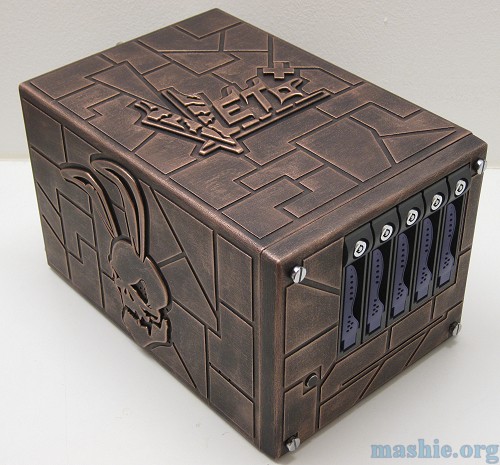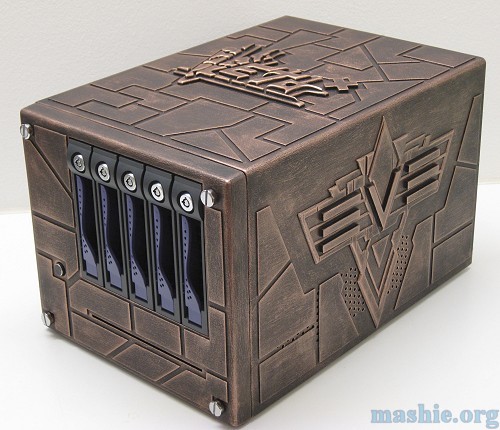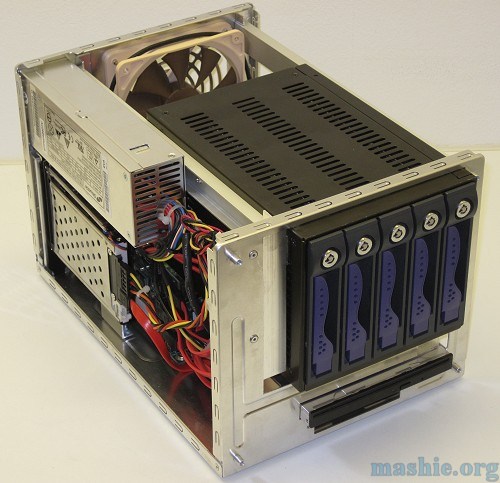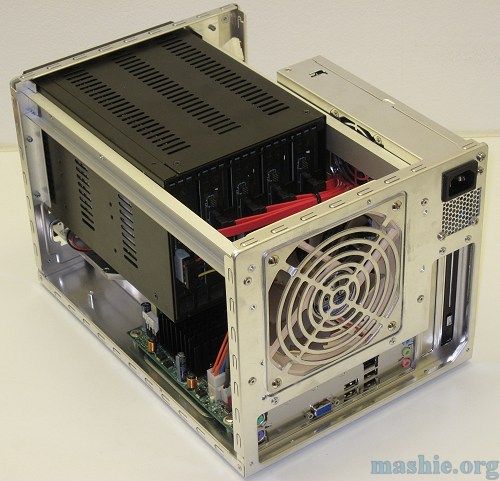blinkenflamingo
Weaksauce
- Joined
- May 22, 2011
- Messages
- 116
Newest addition:
EMC² CLARiiON AX150 /w 12x 500GB HDDs

Connect the second power outlet too
Follow along with the video below to see how to install our site as a web app on your home screen.
Note: This feature may not be available in some browsers.
Newest addition:
EMC² CLARiiON AX150 /w 12x 500GB HDDs

is there any reason to use 1TB for os drive?
I recently updated my configuration. I'm now running ESXi to virtualize my router, TV recording box, and file server in one piece of hardware (and saving 100+ watts over my last setup!).
Total storage (all in one box): 24.113TB
Hardware list:
- Supermicro H8DCL-iF (6F was an option, but would have needed fan-in cables to work, which is icky)
- 16GB DDR3 ECC (for now, 32GB coming up one of these days)
- Opteron 4170, possible upgrade to 4234 later. 6 cores, 2.1 GHz, 50W TDP.
- VMware ESXi 5.0
- 32GB SSD as boot disk/datastore for ESXi
- 6 5k3000 3TB drives, main data store (raidz2)
- 6 7k1000 1TB drives, backups (raidz3)
- USB3 controller for PCI passthrough (AVR experiments)
- Supermicro AOC-USAS2-L8i LSI SAS2008 controller, passthrough to the file server
- HP SAS expander (awesome piece of kit)
- Intel 6300 AGN wireless card, passthrough to firewall
- Ceton InfiniTV card, passthrough to Linux box (since the Windows VM apparently won't deal with it directly)
- Enermax ERV1050EWT Revolution85+ 1050W modular power supply
- Norco RPC-4220
- ANS-9010B ram drive for ZIL, 1GB ECC ram installed
- 80GB laptop drive from old machine, so I can retrieve anything I need from it
I'm currently running 4 production VMs: one OpenIndiana for storage and file serving (which serves an NFS share back to the ESXi host), one PFsense for routing my Internet connection, one Linux for handling the Ceton card and the USB/AVR experiments, and a Windows 7 box for running the vSphere client over remote desktop and WMC.
I have 12TB more storage (6 2TB drives) sitting on the shelf; I don't need it right now, and it costs power to run them for no reason.
Pictures????
will@thor:~$ zpool list
NAME SIZE ALLOC FREE CAP DEDUP HEALTH ALTROOT
backup 5.44T 2.09T 3.35T 38% 1.00x ONLINE -
huge 16.2T 10.6T 5.66T 65% 1.00x ONLINE -
rpool 15.9G 3.05G 12.8G 19% 1.00x ONLINE -

It's not much storage to brag about, but i thought i would post pictures of Inside & out of a QNAP 410u.
4 x 1tb drives @ 7200 with raid 5 & hotspare..
How loud are those little fans? I've wanted to get one of these for a long time, but the noise seems like it would kill the deal. I have used some Dell 860's that are pretty quiet, so hopefully this unit is smart enough to slow down.
Hello
please find underneath my new server based on PC Q25
CASE : Lian Li PC-Q25
PSU : BeQuiet 350W 80+ Gold
MB : Asus P8H67-I
CPU : Core I3-2100
RAM : Gskill DDR3 1600
STORAGE : 12.064 TB
- SSD OCZ 64 GB
- 2*2TB WD EARS
- 1*2TB WD EARX
- 2*2TB Samsung F3 ECO 2
- 1*2TB Seagate Green
PCIE : Sata/Esata 3 Card
OS : Server 2008 R2
- Video& music streaming
- UPNP
- FTPES
-
Connected to gigabit lan and optical fiber 100/100MB





For those with these 10+ TB systems, how much maintenance are they on average?
I mean, how often does a hard-drive die and require replacement? Is it hassle-free to just swap it out or remove it, or does it takes some time/effort to get things back to the point you don't have to keep doing something?
Do you have two harddrives just there, or are they attached to something?
How do you find out that there's a failed drive? Does it let you know somehow on its own, or do you have to keep checking yourself manually?For me, little hassle.
Logon to server console and identify failed drive
Shut down server and remove failed drive
Remove failed drive from its caddy and replace with a fresh drive (i have spares)
Replace new drive
Reboot server
Start rebuild
Send failed drive back to seagate
I think he meant if it's connected to the computer via a data cable, or if it's sitting unconnected.at one point i had 3x 80mm fans in the bottom of the case the the screw holes for the fans just happen to line up with the harddrive holes in their current position
I think he meant if it's connected to the computer via a data cable, or if it's sitting unconnected.
How do you find out that there's a failed drive? Does it let you know somehow on its own, or do you have to keep checking yourself manually?
How often, on average, do you have to deal with a failed drive? Once a year? Once a month?
How do you find out that there's a failed drive?
For those with these 10+ TB systems, how much maintenance are they on average?
I mean, how often does a hard-drive die and require replacement? Is it hassle-free to just swap it out or remove it, or does it takes some time/effort to get things back to the point you don't have to keep doing something?
I have my hard drives hung from a 1/8" piece of plywood. They are held in place with 2 screws. Unplug, sunscrew. Screw, plug.
I have learned to not post anything that might be traced back to me.
But it is nothing fancy. A piece of plywood 5"x11" with 2 rows of holes. Each with 8 holes spaced 1-1/4" apart I think the holes are a little bit sloppy for 8-32 screws. (the screws go in the sides of the drives)